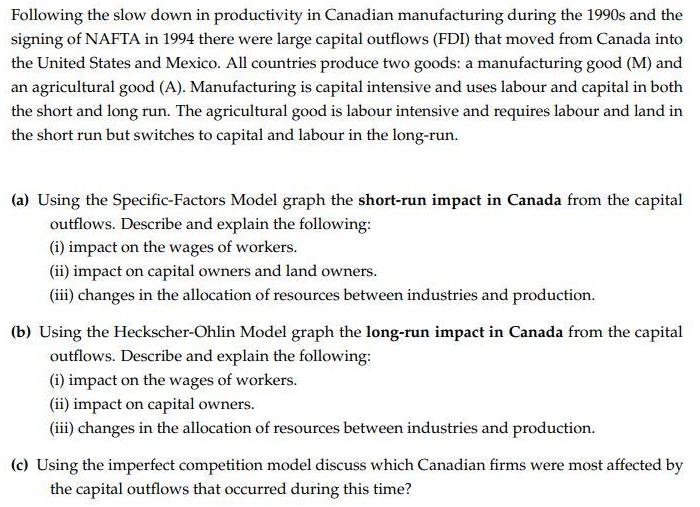Answered step by step
Verified Expert Solution
Question
1 Approved Answer
Following the slow down in productivity in Canadian manufacturing during the 1990s and the signing of NAFTA in 1994 there were large capital outflows

Following the slow down in productivity in Canadian manufacturing during the 1990s and the signing of NAFTA in 1994 there were large capital outflows (FDI) that moved from Canada into the United States and Mexico. All countries produce two goods: a manufacturing good (M) and an agricultural good (A). Manufacturing is capital intensive and uses labour and capital in both the short and long run. The agricultural good is labour intensive and requires labour and land in the short run but switches to capital and labour in the long-run. (a) Using the Specific-Factors Model graph the short-run impact in Canada from the capital outflows. Describe and explain the following: (i) impact on the wages of workers. (ii) impact on capital owners and land owners. (iii) changes in the allocation of resources between industries and production. (b) Using the Heckscher-Ohlin Model graph the long-run impact in Canada from the capital outflows. Describe and explain the following: (i) impact on the wages of workers. (ii) impact on capital owners. (iii) changes in the allocation of resources between industries and production. (c) Using the imperfect competition model discuss which Canadian firms were most affected by the capital outflows that occurred during this time?
Step by Step Solution
★★★★★
3.53 Rating (156 Votes )
There are 3 Steps involved in it
Step: 1
a Using the SpecificFactors Model graph the shortrun impact in Canada from the capital outflows Describe and explain the following i impact on the wag...
Get Instant Access to Expert-Tailored Solutions
See step-by-step solutions with expert insights and AI powered tools for academic success
Step: 2

Step: 3

Ace Your Homework with AI
Get the answers you need in no time with our AI-driven, step-by-step assistance
Get Started


